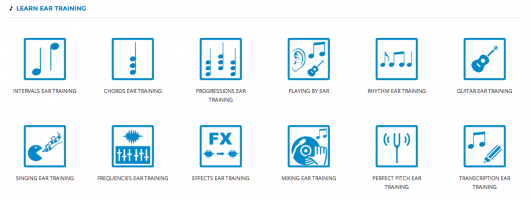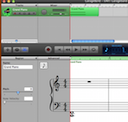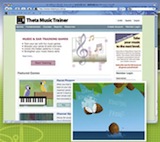Whether you get your ear training exercises from traditional methods like books or classroom teaching, use special aural skills websites online, or do interactive exercises using web or mobile apps, starting to exercise your ears for musical skills will help you improve quickly as a musician.
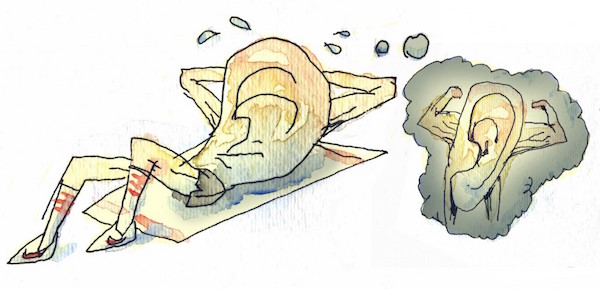
What are ear training exercises?
Ear training is the process of developing your ear for music – and ear training exercises are… just what they sound like! Special repetitive methods you can use to hone your musical ear.
These musical exercises can help you train your ears to recognise notes in music so that your aural skills match your instrument skills and you find it easy to do things like play by ear and create your own music.
Ear training exercises are the “drills” of ear training, used to practice core skills repeatedly until you’ve truly mastered and internalised them. You can start with basic exercises for the fundamentals. There’s no barrier to entry, any beginner musician can (and should!) be using ear training exercises. Once you have internalised the fundamentals, you can move on to more advanced training and testing with more sophisticated ear training drills.
In this way you can develop your ears quickly and transition from hearing the same thing that any random person on the street does, to hearing music the way a professional musician hears it.
Practising ear training builds your awareness and understanding of the underlying components of music and strengthens your ability to relate the sounds to the theory, anticipate what will comes next in the music, and connect it all to your fretboard or keyboard.
Many smart ear training professors will tell you that regularly using these ear training exercises is the best way to develop these musical listening skills and become a confident musician.
Want to identify the elements you hear in music?
Want to sing more confidently?
Want to easily anticipate what comes next in music?
Master the ear training skills and you will master music!
So if these ear training exercises are so powerful,
why don’t more musicians use them?
The truth is that:
- Many musicians do use them – ask any undergrad student on a music degree or conservatory musician, and they’ll tell you all about their daily ear training exercises
- The traditional kind of ear training exercise is pretty boring!
Ear training exercises don’t need to be boring though (read on to discover some great ways to avoid this problem) and if used correctly they lead to rapid progress in developing your musicianship.
Because the traditional methods are boring, they have mostly remained the territory of serious musicians, advanced students, professionals and jazz experts. Increasingly though, modern technology is making these ear training exercises more fun and more accessible, so that we’re now seeing them used by teachers in high school and by individual music learners.
The Traditional Approach
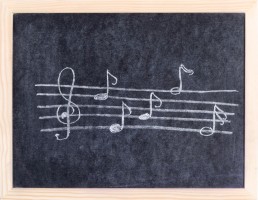
So what are the traditional ear training exercises? Well in the classical era, an exercise would probably mean sitting at a piano keyboard, drilling intervals or chords and using a “brute force” approach to drum the sounds into your ears.
In many conservatories and undergrad music courses, unfortunately the practice of ear training remains much the same as that!
Students are taught by the institution’s staff to practice listening to e.g. intervals, recognising their type, identifying them by ear and by name. The next step is often to reproduce them, either by singing or on their instrument.
The exercises are repeated, drilling the sounds into the student’s head. Often there’s then a corresponding test – either an informal check of their ability or a more serious exam – to see mistakes they’re making. The student listens, guesses their “answer” and finds out if it was correct or incorrect. Based on their mistakes they might be graded, and get feedback on what they got right and wrong. Ideally this is followed by advice and encouragement from the professor to help them keep improving.
By the time they reach their final ear training exam, many music students are bored and frustrated by ear training – a search for “ear training” on Twitter around exam time will quickly confirm this!
This experience of ear training clearly leaves much room for improvement, but the basic process is sound and has worked for hundreds of years:
- Learn the fundamental theory and concepts you need to understand the topic.
- Spend time listening to repeat examples, building up from the simple to more complex. Sing and identify each example.
- At each stage, test yourself (or have a partner test you) to check your progress and identify areas for improvement.
- Use this analysis of mistakes to know how to improve.
- Continue improving your ears, gradually introducing other more advanced topics.
So how can this process of using ear training
exercises be done better in the modern age?
The Modern Approach

As with so many things today, the answer lies in taking proper advantage of modern technology. Instead of reading notation from a book and bashing away at a grand piano, modern ear training is more likely to involve tapping a touch screen or listening to specially-crafted MP3 tracks on headphones.
Today you can go online with your computer or tablet and find a range of ear training websites which provide exercises that are easier, better and faster than traditional methods. Not to mention the interactive mobile apps like iPhone apps which are so popular because they truly make exercising your ears an engaging experience.
They still involve repeat practice, finding out what you’re getting correct and incorrect, and getting advice on improving. But they make it easier and more fun and deliver faster results because technology allows for much better feedback. Often you can see your accuracy displayed on screen continually so you know you’re improving. You can check your progress at any stage, and levels, scores and achievements (like quests and stars) can help you stay on track and keep motivated. Sometimes you can post your high scores and share results with other students. The comments posted and encouragement you receive can really keep you devoted to training your ears.
Even if you’re a more private person, the progress tracking, customisation and interactivity can make tech-powered ear training exercises very valuable indeed. Not to mention they help you stay regular in your practice and keep up a daily schedule of ear training, reminding you if you forget and helping you continue your ear training journey.
For more about using these technologically-enhanced ear training methods to develop your listening skills, see the section later on going beyond ear training exercises.
Already know what ear training exercises are and how to effectively plan how you use them?
Jump straight to the exercises themselves:

